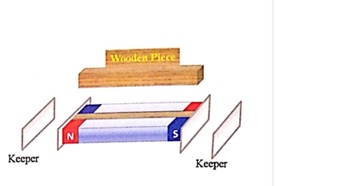You Must Know
1. A magnet is a device, or ‘set-up’, that can attract certain materials, such as iron, nickel and cobalt.
2. Magnets can be natural or artificial (man-made).
3. Artificial magnets can be either permanent magnets or temporary magnets.
4. The materials, which get attracted by a magnet, are called magnetic materials. Iron, steel, cobalt and nickel are well known examples of such materials.
5. The materials, which are not attracted by a magnet, are called non-magnetic materials. Wood, plastic, paper, and a large number of other materials, are all non-magnetic materials.
6. Poles, of a magnet, are the regions where the strength of this magnet is at its maximum.
7. Bar magnets, and horse shoe magnets, have a ‘north’ and a ‘south’ magnetic pole.
8. When a bar magnet is suspended, so that it can move freely, it always points along the North-South (N-S) direction.
9. The ‘like poles’ of two magnets repel each other while their ‘unlike poles’ attract each other.
10. The Earth itself behaves like a huge magnet.
11. A magnetic compass is a device used to find directions. It is a magnetic needle which can move freely on a pivot.
12. Magnets lose their magnetism if heated, hammered or dropped from a height.
13. Magnets need to be stored properly when not in use.
Something To Know
A. Fill in the blanks.
1. The materials which do not get attracted toward a magnet are called non-magnetic materials.
2. The bar magnet is an example of a permanent/artificial magnet.
3. Even the smallest piece of a bar magnet has two poles .
4. Earth has its magnetic north pole towards its geographical south pole.
5. Magnets have been used for Navigation/various purposes.
B. Write True or False for the following statements.
1. Naturally occurring magnets are called loadstones. True
2. An aluminium foil would get attracted by a magnet. False
3. Bar magnets have a ‘north seeking’ pole as well as a ‘south seeking’ pole. True
4. Two magnetic poles, of the same kind, attract each other. False
5. When two magnets are moved farther apart from each other, the forces, that attract or repel them, tend to become stronger. False
C. Tick (✔) the correct option.
1. The magnetic material, that was discovered first of all, is-
iron
loadstone
steel
cobalt
Answer – loadstone
2. A magnet can attract-
a glass object
a book
a flower
an iron nail
Answer – an iron nail
3. A material, that is often used to make a temporary magnet, is—
steel
ticanol
alnico
soft iron
Answer – soft iron
4. When we suspend a bar magnet from a thread, it comes to rest along the-
north-west direction
east-west direction
north-south direction
south-west direction
Answer – north-south direction
5. A device, which generally does not use a magnet, is-
a CD player
a geyser
a telephone
an electric motor
Answer – a geyser
D. Answers the following questions in brief.
1. State any two properties of a bar magnet.
Answer – 1. Two properties of a bar magnet are-
Attractive property – The magnet is capable of attracting a small piece of iron, steel, etc.
Directive property – A freely suspended magnet always points along with the north and south directions.
2. Maximum iron filling stick to the two ends of a bar magnet. Why?
Answer – Maximum iron filling sticks to the ends of a bar magnet because the strength of a bar magnet is maximum near the poles.
3. Suppose we bring the north pole of one bar magnet towards the north pole of another freely suspended bar magnet. What are we likely to observe?
Answer – We observe that the two poles repel each other when we bring the north pole of one bar magnet towards the north pole of another freely suspended bar magnet because like poles repel.
4. Two magnets, X and Y, are placed as shown in the diagram. It X is observed that magnet X floats above magnet Y. Give reason for this observation.
Answer – Magnet X floats above magnet Y because the two magnets X and Y are having the same poles towards each other.
5. You are given a knitting needle made of steel. How can you make it into a magnet?
Answer – We can make the steel needle into a magnet by placing it near a bar magnet for some time, this is because the steel needle acquires some magnetism.
E. Answer the following questions.
1. Distinguish between the following:
(a) permanent magnets and temporary magnets.
Answer –(a) Permanent magnets and temporary magnets
Permanent magnets are magnets that once made remain as magnets for a long period of time, whereas temporary magnets are magnets that once made remain as a magnet only for a short interval of time.
Steel, cobalt steel, alnico and ticanol are some of the materials that are used for making permanent magnets, whereas soft iron and nickel are two of the materials used for making temporary magnets.
(b) magnetic and non-magnetic materials.
Answer – Magnetic and Nonmagnetic materials
Materials that get attracted towards a magnet are called magnetic materials, whereas materials that do not get attracted towards a magnet are called non-magnetic materials.
Examples of magnetic materials are iron, steel, cobalt, nickel, and examples of non-magnetic materials are paper, wood, and rubber.
2. Two bar magnets, ‘P’ and ‘Q’ are kept as shown in the following diagram.
a – b c d
‘P’. Repel →’Q’
(a) If Point ‘c’ represents the south pole of the magnet Q, which point represents the north pole of magnet P?
Answer – Point ‘a’ represents the north pole of magnet P.
(b) What will happen when the end ‘d, of magnet ‘Q’ is brought towards the end ‘b’ of magnet ‘P’?
Answer – The two ends will attract each other when the end ‘d’, of magnet ‘Q’ is brought towards the end ‘b’ of magnet ‘P’.
3. Describe, in brief, the construction of a compass needle. State its main use.
Answer – The compass consists of a magnetic needle pivoted at its center and free to rotate a horizontal plane. The needle is fitted in a horizontal box having a glass cover. The compass also has a dial with directions marked on it. It is used to locate the north and south direction at that place.
4. Draw a labelled diagram to show the ‘proper way of storing two bar magnets’, when they are not in use. State the advantage of such a ‘proper storing’.
Answer – Diagram to show the proper way of storing two bar magnets’ when they are not in use.

The advantage of proper storing of bar magnets is that bar magnets do not lose their magnetism for a long period.
5. Write the different ways through which magnets can be made to lose their magnetism.
Answer – Different ways through which magnets can be made to lose their magnetism are –
Magnets lose their magnetic properties when heated or mishandled (dropped/hammered).
If magnets are not stored properly their strength keeps on decreasing with time.
6. Anushtha saw a steel clip at the bottom of a very shallow puddle of water. She used a magnet, to take out this clip, without wetting her hands, or the magnet. Describe how she must have done this.
Answer – She must have done this with the help of a strong magnet that can attract steel clips from a distance too.
Value Based Question
Aryan, the son of an Army man, always behaved, towards others, in a polite, helpful and considerate way. He was also a very hard working and disciplined boy. When his father was transferred to a new location, he too had to move to a new school. He soon had many friends in his new school. His teachers would often say:
‘Aryan’s personality helps him to attract friends in the same way as a magnet attracts iron objects towards it.
1. State the qualities of Aryan’s personality, that you would yourself like to have.
Answer – Politeness, disciplined, hard-working, friendly.
2. State one practical use of a magnet’s property of attracting iron objects.
Answer – Electromagnets can be used in mobile cranes(for lifting or transferring magnetic materials like scraps of iron.
3. Have a ‘story-telling game’ in which the participants think of a situation in which a person’s
(a) kind/polite nature
Answer – If a student is kind and polite towards other students, then the other students may help him/her at needs.
(b) helpful nature
Answer – (b) If one is helpful to his/her mother, then the mother feels good and cares more for him/her.
(c) hard working nature
and so on helps her/him, in one way or the other.
Answer – If one is hardworking in his practice for annual sports, then he/she may get trophies in some of the sports.
Something To Do
1. Design a colourful maze on a gameboard made of cardboard. Your maze should include a ‘start’ and a ‘finish’ line and a path wide enough for a steel paper clip to move through it. Draw, and colour, you favourite characters on a thick piece of paper. Make a ‘cut out’ of these and fit them into paper clips. Keep one of your ‘cut outs’ at the ‘start’ line and move it through the maze using a magnet held below the ‘gameboard. The student, who moves the ‘cut out, through the maze, to the ‘finish’ line, in the shortest duration of time, wins the game.
Answer – Students will do this at their own
2. ‘Discovery of magnets has improved the quality of our life.’ Do you agree with this statement? Write your views on a piece of paper and share your views with your friends.
Answer – Yes, discovery of magnets has improved the quality of our life. Foe example the compass needle has helped humankind in long distance voyages since ancient times. Many modern gadgets use magnet example electric motor and speaker. Recording devices like CD, DVD, is also used magnet for recording.
3. Is soil a magnetic or a non-magnetic material? Find it out by collecting samples from different parts of the colony/city. List the findings in a tabular form as shown below.
Name of Location
Did you find iron-fillings sticking to the soil? (none/few/many)
Answer – Take soil sample and keep it near the bar magnet. If the soil sample contains iron particles they will stick to the magnet because soil in certain places contains iron.
4. Suppose you are given two equal sized iron rods, one of which is a magnet while the other is not. Both the rods are similarly painted and have identical appearance. Imagine that you do not have any other object with you and you do not know which way the ‘north’ direction is. How will you be able to determine which rod is magnetic and which rod is non-magnetic?
(Hint: Use the ‘maximum strength at the poles’ property of a magnet.)
Answer – Suspend both the rods separately by a thread. The thread should be tied in middle od each rod. Allow each rod to come to rest. The rod which always points towards north-south direction is the magnetic rod. Repeat this activity at least four times to confirm the magnetic rod.

